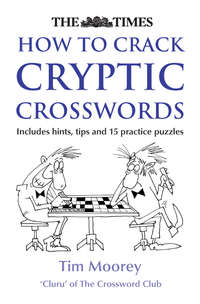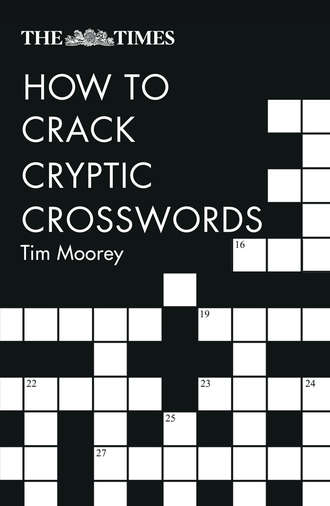
Полная версия
The Times How to Crack Cryptic Crosswords

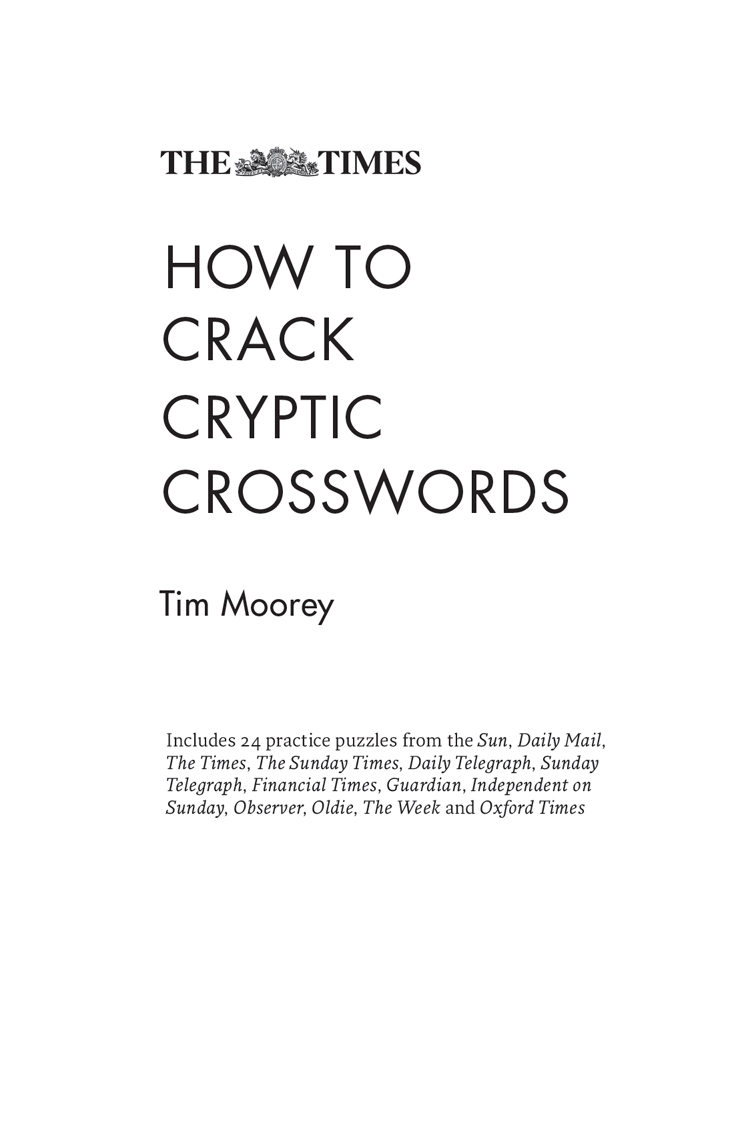
Copyright
HarperCollins Publishers
Westerhill Road
Bishopbriggs
Glasgow
G64 2QT
www.harpercollins.co.uk
Copyright © Tim Moorey 2018
Puzzles © Daily Mail, Daily Telegraph, Sunday Telegraph
The Times® is a registered trademark of Times Newspapers Limited
10 9 8 7 6 5 4 3 2 1
Layout by Susie Bell – www.f-12.co.uk
All rights reserved under International and Pan-American Copyright Conventions. By payment of the required fees, you have been granted the nonexclusive, nontransferable right to access and read the text of this e-book on-screen. No part of this text may be reproduced, transmitted, downloaded, decompiled, reverse-engineered, or stored in or introduced into any information storage and retrieval system, in any form or by any means, whether electronic or mechanical, now known or hereafter invented, without the express written permission of HarperCollins e-books.
The contents of this publication are believed correct at the time of printing. Nevertheless the publisher can accept no responsibility for errors or omissions, changes in the detail given or for any expense or loss thereby caused.
A catalogue record for this book is available from the British Library.
If you would like to comment on any aspect of this book, please contact us at the given address or online via email: puzzles@harpercollins.co.uk


Source ISBN: 978-0-00-828557-9
Ebook Edition © JUNE 2018 ISBN: 9780008285593
Version: 2018-06-29
HarperCollinsPublishers has made every reasonable effort to ensure that any picture content and written content in this ebook has been included or removed in accordance with the contractual and technological constraints in operation at the time of publication.
Dedication
To my dear Pam, partner for over 50 years without whose…
(her no-nonsense modesty prevented me from completing this!)
Contents
Cover
Title Page
Copyright
Dedication
Introduction
Part 1:
Crossword Basics
1 Terminology
2 Overview of Clues and Indicators
3 Clue Types and Indicators in Detail
4 Tips for Solving Clues
5 Tips for Solving the Whole Puzzle
6 The Knowledge
7 Ten Things to Consider When Stuck
Part 2:
Mastering the Finer Points
8 Finer Points: by Clue Type
9 Finer Points: General
10 Ten Especially Troublesome Words
11 Ten Ways to Raise Your Game
Part 3:
Practice Time
12 Recommended Books, Websites & Media
13 Practice Clues by Type
14 Practice Puzzles
15 Difficulty Ranking in Newspapers
Part 4:
Appendices
1 List of Abbreviations
2 Solutions: Practice Clues
3 Solutions: Practice Puzzles
4 Thanks
Index
About the Publisher
Introduction
“In Victorian times a popular game was Magic Square… In 1913 Arthur Wynne was given the task of devising a new puzzle for the World. He adapted the magic square by blackening in some squares and criss-crossing the words. Thus was the first ever crossword puzzle created.”
The Advertiser, Adelaide
What’s the aim of this book?
I hope to show that, for any daily or weekly crossword puzzle, it is possible to improve your solving skills substantially by the study and application of a few straightforward rules and techniques.
So, is this book only for beginners?
Not at all, it is also for anyone wanting to master crossword puzzles so he or she isn’t regularly left with unfinished clues before the next day’s newspaper arrives. It may also appeal to others happy to enjoy many first-rate clues and practice puzzles from the sources that abound in the book.
Is there a typical person who might benefit?
Whilst I wouldn’t wish to deter others, the person who enjoys a daily struggle with a Quick (non-cryptic) crossword appearing in nearly every newspaper, is an ideal recruit to the world of cryptics. He or she will soon find that they are being given only one way of cracking a clue ie by definition only; cryptics more often than not have two ways, sometimes more, and take full advantage of the delights and richness of the English language.
What are my qualifications?
My experience as:
1 A (not very fast) solver of crosswords for over 60 years, starting with the London Evening News, followed by the Radio Times and the News Chronicle.
2 A crossword setter whose first crossword was published in the Evening News in 1956.
3 Author of How to Master The Times Crossword (HarperCollins 2008) which explained cryptic clues in innovative charts that have been well received and are again used in this book.
4 A tutor of crossword workshops around the country for adults and children for over 20 years.
Is this then an update of How to Master The Times Crossword?
Feedback on this first book showed that it proved useful for solving crosswords other than The Times. This encouraged me to write a generic book, How to Crack Cryptic Crosswords in 2014, applicable to just about any crossword with puzzles and clues from a variety of sources, not only The Times.
Is this then an update of How to Crack Cryptic Crosswords?
Yes it is, for the following reasons:
Practice being crucial, to give more solving opportunity via 24 all new puzzles from a variety of publications. Each is partnered by detailed explanations as to why answers are what they are;
It contains many new example clues explaining the basics even more clearly than before and uses the same explanatory diagrams that proved popular in my earlier books;
The update has been written after gaining from my workshops lots more experience of what new solvers find most helpful. To that end, many new clues should seem easier than their predecessors;
The launch of the Times Quick Cryptic. Smaller and easier than the main Times Crossword, this has proved to be an excellent puzzle for teaching newcomers and is used extensively in the present update;
There are many new internet sites and media outlets for cryptics.
My hope is that these features provide good reason for total newcomers and my previous readers of both books to enjoy and learn from this update.
Are there rules and conventions applying to all cryptic crosswords?
It surprises people to hear that there are, as set down by Ximenes (see box) and they are followed to a large extent by the clue writers and crossword setters whose work appears here.
So which crosswords are not covered?
Barred crosswords such as Mephisto (Sunday Times), Azed (Observer), the Inquisitor (the i), Beelzebub (the Independent on Sunday), Enigmatic Variations (Sunday Telegraph) and the Listener Crossword (in the Saturday Times) are not used as examples. Solvers of these puzzles at the top of the difficulty scale are not in need of instruction.
XIMENES AND AZED
Having taken his name from a Grand Inquisitor in the Spanish Inquisition, Ximenes (Derrick Macnutt), a Marlborough College student and Classics master at Christ’s Hospital, was long-term setter of a crossword puzzle in the Observer. He is remembered today, not just for his puzzles, but also because he set out fair and consistent principles for cryptic crosswords, design and clues in a ground-breaking 1966 book Ximenes on the Art of the Crossword, reissued in 2001. His successor Azed (Jonathan Crowther) and the majority of setters today in national media follow virtually all of what are known as ‘Ximenean’ principles. See here for more on these.
What about Jumbo crosswords?
No examples of these puzzles are included on the grounds of space but the clueing and solving principles and practice described are just as relevant to their solvers.
What’s the book’s focus?
It’s firmly on the solver. The teaching sections have been written after consulting a large number of solver friends, colleagues, acquaintances and workshop students, much of whose experience and techniques are incorporated. To this end, a setter’s blog in the previous book is replaced by practice puzzles.
Are there rules for solving?
No, and I certainly would not wish to be seen as laying rules down. Everyone finds their own way of doing crosswords and my hope is that I help you to find yours. Also I invite you to adopt or reject the tips according to whether they suit you.
One thing I will point out, albeit hesitantly, is that on my workshops, female students tend to be ‘instinctive’ solvers (initial guess and work out why afterwards) whereas male students tend to be more ‘analytical’ in their initial solving. But that’s naturally not always the case: the key point is that it doesn’t matter which type you are.
How to reinforce the teaching?
I follow the well-established teaching principle that adults learn best by doing, rather than reading or being talked at. So I have included lots of practice clues and puzzles, with detailed explanatory notes setting out the solutions to every practice clue and puzzle. They should leave you in no doubt about why the solutions are what they are, a common frustration for solvers. Finally, a full index is designed to encourage the book’s continual use, rather than a book that you read once and then donate to a charity shop.
The practice clues in Chapter 3 come from a variety of sources and many are to savour, as they have been selected as ‘The Clue of The Week’, a feature of The Week magazine for the past 20 years.
Why do people shy away from cryptics?
There are many fears and misapprehensions about the cryptic crossword, usually displayed at the start of my workshops. It is commonly thought that:
you require a good knowledge of rare words, literature and the classics;
clues lead to more than one answer;
the cryptic is always harder than the Quick, non-cryptic puzzle
there are no rules;
you need to have ‘that sort of mind’.
I hope by the end of this book to have dispelled, partly or wholly, all of these myths.
What sort of knowledge is needed?
On my workshops I’ve discovered that any moderately well-educated person with a love of language and problem-solving, and average general knowledge can complete a cryptic crossword. On these points, Richard Browne, a former Times crossword editor, has explained:
‘Thirty years ago setters could confidently expect that most solvers would have a reasonable acquaintance with the principal plays of Shakespeare, the main characters and events in the Bible, probably a bit of Milton, a few lyric verses, Dickens perhaps, certainly Sherlock Holmes and some staples of the Victorian nursery such as Lear and Lewis Carroll, and you could confidently clue a word just with a reference. That doesn’t work any more, partly because the world has widened up so much.
‘We have lots of people in this country now from different backgrounds – India, Africa, America, whatever – who have a different system of education, and of course we have people logging on worldwide to Times Online, doing the crossword. So it’s a larger and more varied audience – you’re no longer talking exclusively to the public-school, Oxbridge types who were the core of your readership 50 or 60 years ago.’
Importantly, these comments apply to most cryptics published today.
Finally, why do crosswords?
‘I always do the crossword first thing in the morning, to see if I’ve enough marbles left to make it worth my while getting up.’
Letter to The Times from an elderly reader
There is indeed scientific evidence that tackling a crossword can be good for you. Medical research continues to support the notion that mental exercise from activities such as crosswords is beneficial, especially in later life, and stimulates the brain. A New York neurologist, Doctor Joe Verghese, conducted research in this area for over 21 years and found that those who kept their minds nimble were 75 per cent less likely to develop dementia or Alzheimer’s disease.
‘Do something that is mentally challenging to you,’ he has said. ‘It seems that remaining mentally agile makes the brain more healthy and more likely to resist illness, just as physical exercise can protect the body from disease.’
In addition, are crosswords educational? I say yes, in the sense that they undoubtedly can improve your vocabulary and general knowledge.
Incidentally, you can check the number of words in your vocabulary via www.testyourvocab.com, against the average native English speaker’s 27,000 words. Maybe one plan is for you to check your score again after you have mastered this book!
It’s now time to get stuck into some basics, in which I assume no previous knowledge whatever.
A CLUE-A-DAY
Some Indian states have a daily cryptic clue-solving contest for children – see www.crypticsingh.com/acad
PART 1
CROSSWORD BASICS
1: Terminology
“She had another look at The Times Crossword. The clues might as well have been written in a foreign language.”
Simon Brett, The Stabbing in the Stables
The first three chapters of Part 1 establish the terms used throughout. They are essential reading for beginners, and perhaps also for some seasoned solvers who may have become used to different terminology.
What is a cryptic clue?
A cryptic clue is a sentence or phrase, involving a degree of deception, making sense and frequently conjuring an image, or triggering thoughts, in its surface reading; but when read in another way can be decoded using a limited number of well-established techniques to give a solution. Thus “cryptic” is used in its meaning of hidden or misleading.
These are the other terms we shall use:
Answers to clues, running across and down are entered into a grid, popularly a diagram, which has across and down empty squares to be filled.
The grids in the case of the puzzles we are considering here contain black square blocks, hence they are seen in blocked puzzles.
The other main type not being considered here has a grid with bars rather than blocks, hence the term barred puzzles.
Clue answers are variously called solutions, entries and indeed answers.
Where a solution letter, or letters, is able to be confirmed by intersecting entries, they are checked letters. Unchecked letters (unches in the trade) are therefore the opposite: the solver has no second way of confirming them.
The sense conveyed by the initial reading of a clue is the surface meaning.
The person responsible for the crossword is a setter; more commonly, but in a term less attractive to most crossword professionals, a compiler.
The term constructor, which suits puzzles with difficult-to-build grids, is used in North America.
The number of letters in a clue solution, always shown at the end of the clue, is termed the enumeration.
Other terms associated with clues such as wordplay, anagram, indicator and anagram fodder are explained as we meet them.
For completeness, there is a rarely used crossword term – light – whose meaning has fluctuated somewhat from the early days of crosswords but is defined by the Collins English Dictionary today as the solution to a clue.
ARE CRYPTICS EXCLUSIVELY BRITISH?
Commonwealth countries such as Canada, Australia, New Zealand, India, Malaysia, Singapore, Kenya, Malta and South Africa have daily cryptics similar to British ones, as does Ireland. US crosswords are different in that grids are more open and clues are mildly cryptic or straightforward definitions. There are some occasional British-style puzzles in the New York Times and elsewhere. Nonetheless the UK can be considered the home of cryptics. For example, Daily Telegraph crosswords are syndicated to around 20 countries.
CROSSWORDS BETTER THAN SEX: DAILY MAIL ONLINE
When a cryptic crossword is solved, the brain releases dopamine, a chemical agent that makes sex, winning and eating more enjoyable.
2: Overview of Clues and Indicators
“The question is,” said Alice, “whether you can make words mean so many different things.”
Lewis Carroll, Through the Looking Glass
In this chapter I provide a short overview of the basics of clues and how to recognize them. Detailed points on each clue type are the subject of Chapter 3.
Characteristics of a cryptic clue
We will consider twelve types of cryptic clue, of which the majority conform to the principles contained in this image:
Cryptic clues (mostly) have two parts
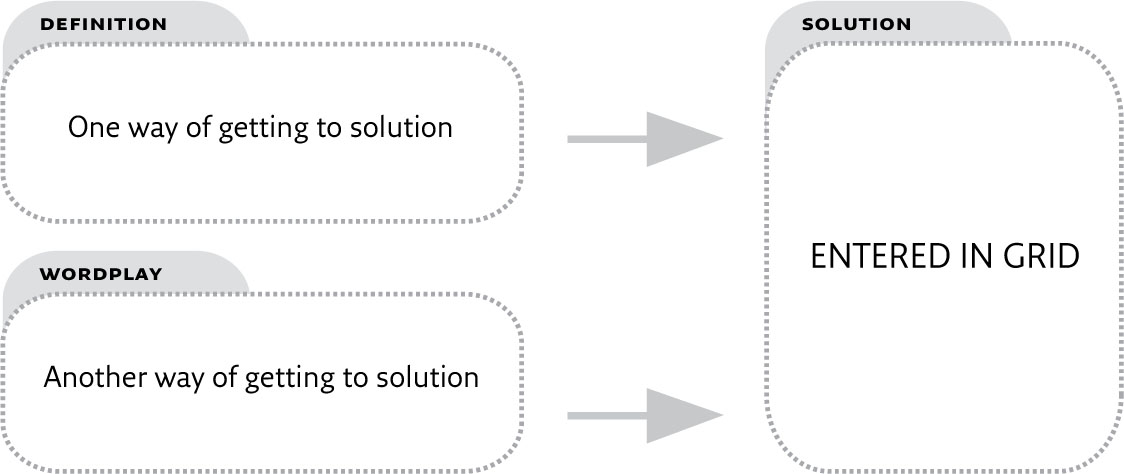
Either the definition or the wordplay can come first in the clue sentence; and either could be exploited first to obtain the solution. Whichever does come second in your solving order acts as confirmation that you have the correct solution.
Taking each element in turn:
Definition: The definition can
take the form of a word, or words in a phrase
be an example of the solution (e.g. fruit can be defined as apple, perhaps)
be a (misleadingly expressed) synonym of the solution. To this end, definitions are often words that have more than one meaning
Wordplay: This is the way to elicit the solution if the definition does not do so. It can be seen as either:
the letters of the solution needing manipulation in one of several ways to provide another indication of the definition, or
individual word or words in the clue having to be interpreted in a different way from the surface meaning
Perhaps strictly accurately the terms should be word and letterplay (though not, as an elderly student once stumbled over, “loveplay”!).
TOP TIP – DEFINITION PLACEMENT
Beginners find it much easier to decode a cryptic clue when they are told that the definition is almost always either at the beginning or end of the clue sentence or phrase.
Solution: This can be one or more words whose word-length is shown at the end of the clue in parentheses (the enumeration).
An example of how this works is seen in this clue which has a simple juxtaposition of three parts from which the solver has to discover which parts are which before progress can be made. Here it could be that either find or above is the definition. In fact it is find.
Find record above (8)
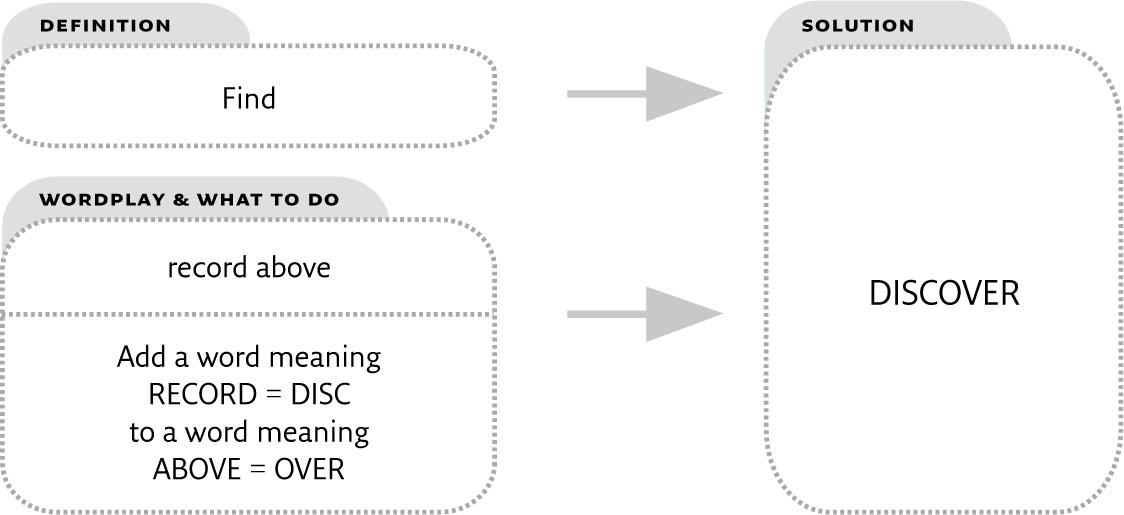
Linkwords: Few clues are as straightforward in construction as the previous example and the first mild challenge is that there is often a linkword between the two parts to give the solution. The chart then is:
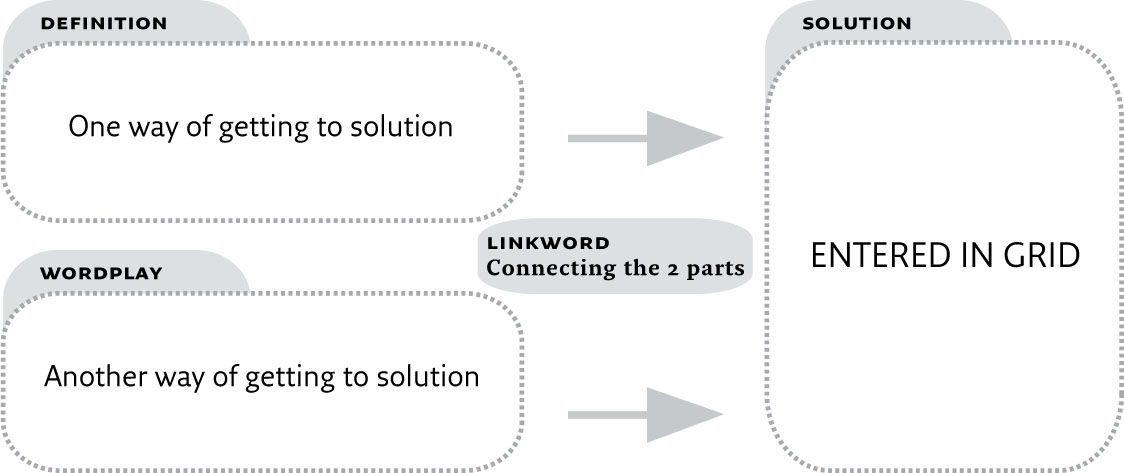
CRYPTIC CLUES WITH LINKING WORDS
Below is a clue which also starts with the definition but, in addition, has a linkword, one that is commonly used: from. The sense conveyed by from is that a synonym for church house can be formed from the two parts earlier and years (if the latter is taken as an abbreviation – more on this later).
Church house from earlier years (6)
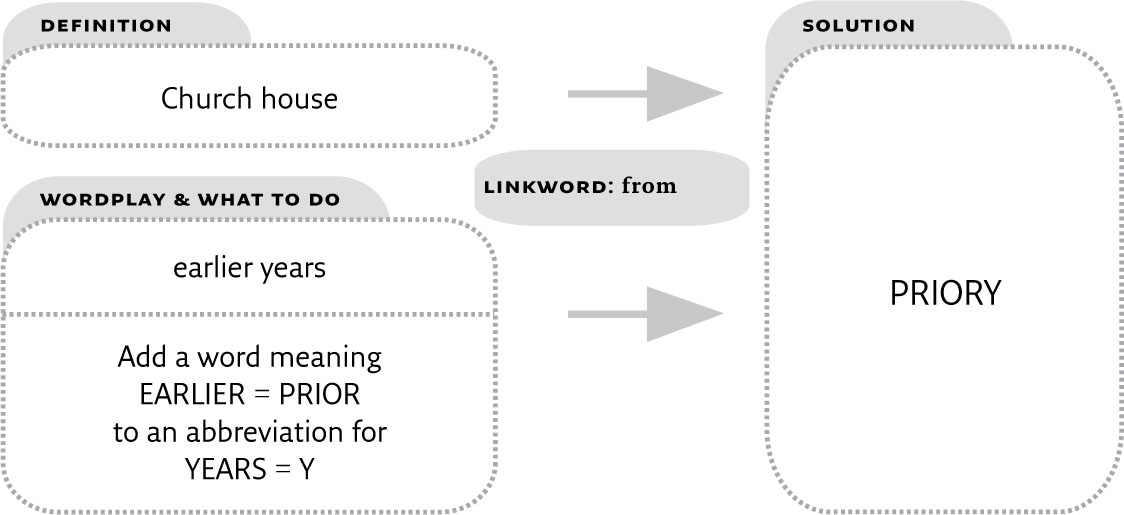
Next is an example in which the definition is the final word in the clue and in which the linkword is in, the sense being that the wordplay is seen in the solution.
ADDITIVE CLUE: Keep wine in northern town (9)
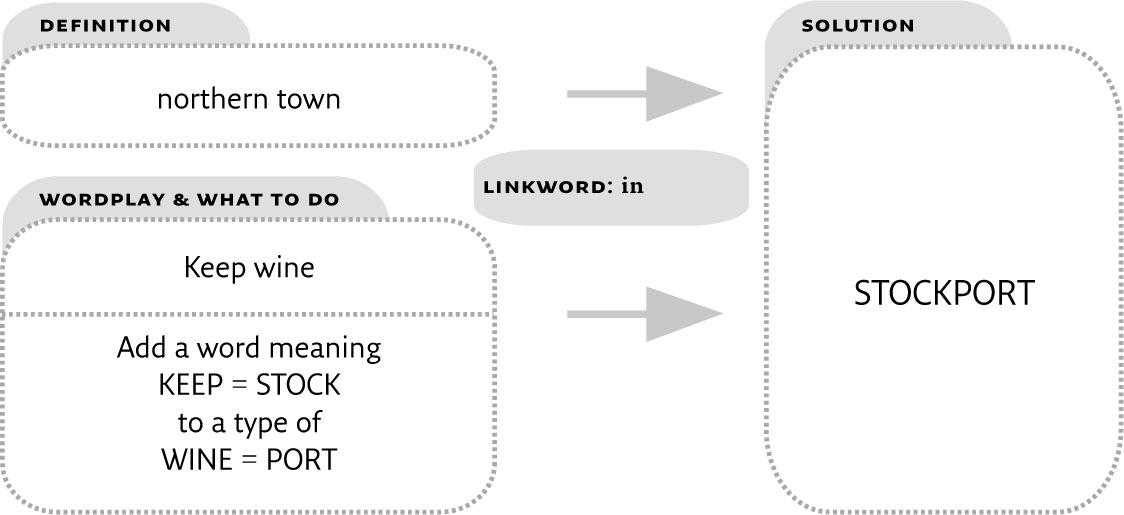
As well as linkwords between definition and wordplay, there can also be similar linkage within the wordplay to connect its different parts. Here it is and, a simple additive indication. The other linkword is indicates that the definition can be formed from the wordplay.
ADDITIVE CLUE: What babies need is sleep and food (7)
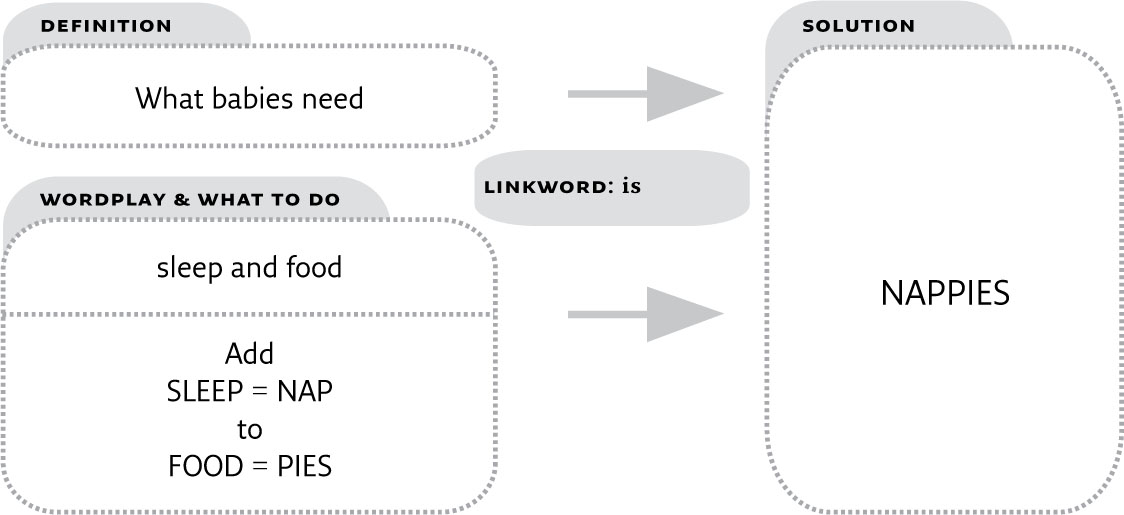
You will notice that the last two of the example clues are labelled additive. In fact all so far have been of this type, a relatively plain construction of A + B = C which we shall consider later in more detail as one of the twelve clue types, dividing these into one group of eight and one group of four. Why split clues into two groups? Because some always contain the means of identifying their type (the first eight) and others virtually always do not (the remaining four). This distinction is amplified in the section which follows.
Indicators
At this point, beginners tend to say:
“Yes, I know that there are different types of clue but how on earth do I know which is which?”
The answer is as follows. For the first group of eight there is always a signpost to the solution, called the indicator, within the clue sentence. Remember, an indicator is the means of identifying clue types. In Chapter 3 we will consider the specific indicators for the first group of eight clue types. In the example the indicator is wrong, showing that this is an anagram clue. The concept behind this indicator is that the letters to be mixed are incorrect and must be changed to form the solution. There are many ways of giving the same anagram instruction to solvers, as you will also see in Chapter 3.


